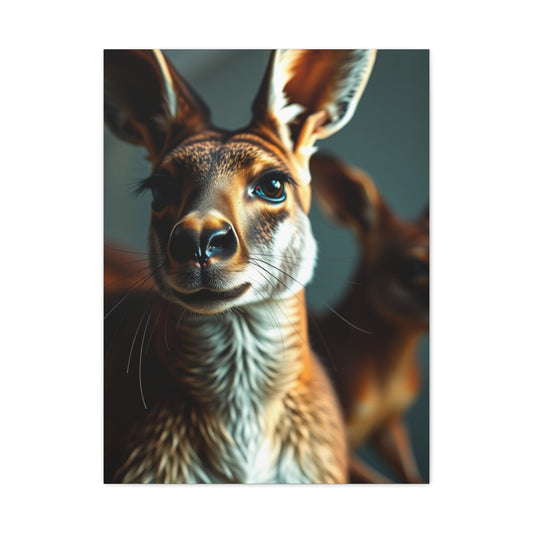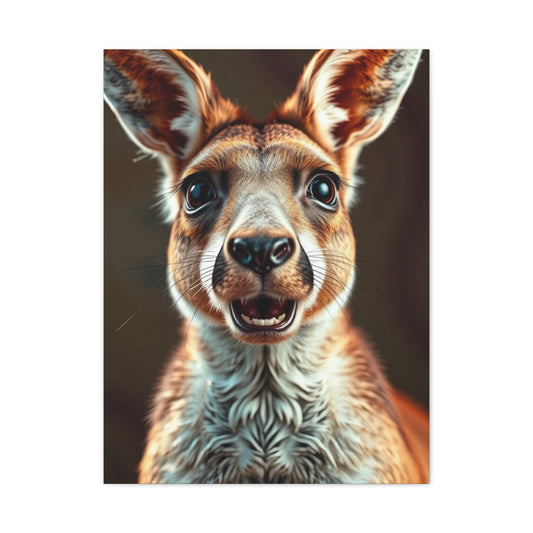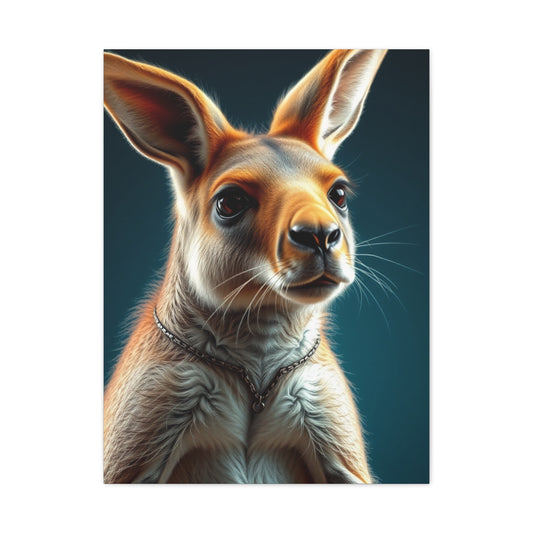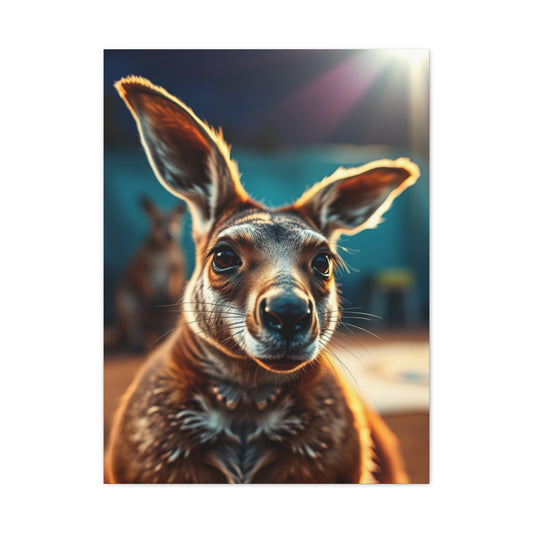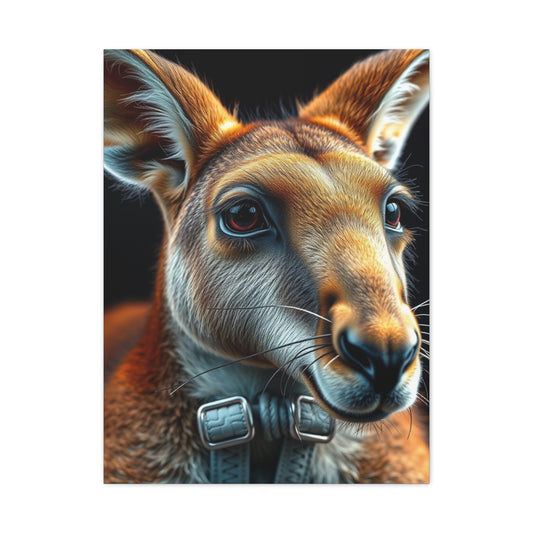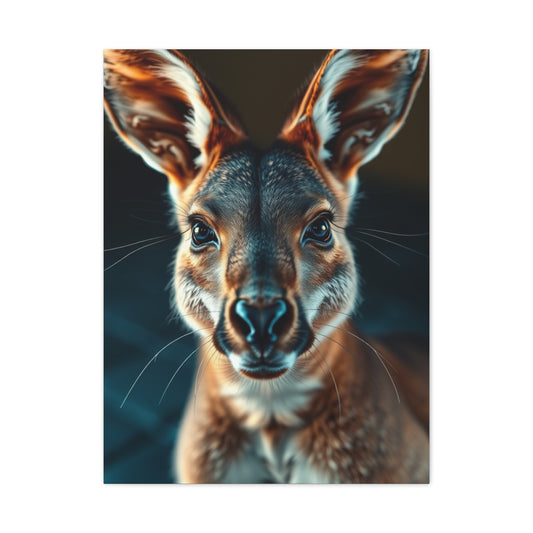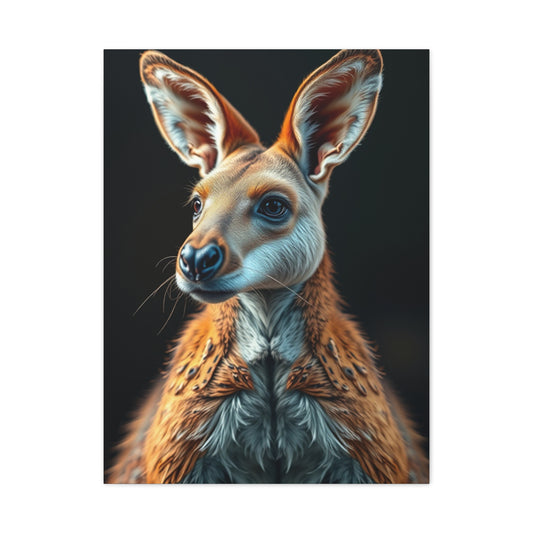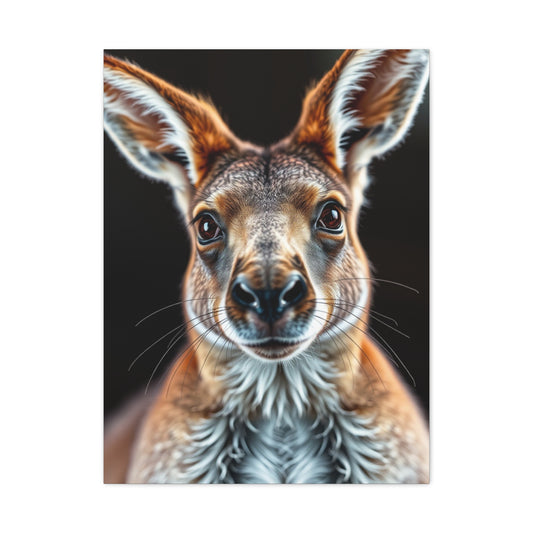Transform Your Living Space with Captivating Kangaroo Wall art Decorations
Kangaroo wall art represents one of the most enchanting ways to bring the essence of Australian wildlife into your home environment. These magnificent marsupials have captured the imagination of artists and home decorators worldwide, offering a unique blend of natural beauty, cultural significance, and aesthetic appeal that transforms ordinary walls into extraordinary focal points.
The allure of kangaroo-themed decorations stems from their distinctive silhouettes, graceful movements, and symbolic representation of strength, agility, and family bonds. Whether you're drawn to abstract interpretations, realistic photography, or stylized artistic renditions, kangaroo wall décor provides endless possibilities for personalizing your living spaces while celebrating one of nature's most remarkable creatures.
Modern homeowners increasingly seek décor elements that reflect their personality, values, and aesthetic preferences. Kangaroo wall art satisfies this desire by offering versatility in style, size, and presentation while maintaining a connection to the natural world that many find both calming and inspiring.
Marsupial-Inspired Home Decorations
The fascination with kangaroo imagery in home décor extends far beyond simple animal appreciation. These creatures embody characteristics that resonate deeply with human values and aspirations. Their powerful hind legs symbolize forward momentum and progress, while their nurturing family structures represent protection, care, and community bonds.
Kangaroo wall art serves multiple purposes in contemporary interior design. It functions as a conversation starter, a cultural bridge connecting viewers to Australian heritage, and a natural element that softens the hard edges of modern architecture. The organic curves and dynamic poses typical of kangaroo imagery create visual interest and movement within static room environments.
Art collectors and casual decorators alike appreciate kangaroo-themed pieces for their timeless appeal. Unlike trend-driven décor that quickly becomes outdated, wildlife art maintains its relevance across changing design movements. The natural forms and earthy tones commonly associated with kangaroo art complement both traditional and contemporary interior styles.
The psychological impact of wildlife imagery in living spaces cannot be understated. Studies suggest that nature-inspired decorations contribute to reduced stress levels, improved mood, and enhanced creativity. Kangaroo wall art specifically evokes feelings of freedom, adventure, and connection to the natural world, making it particularly suitable for homes where relaxation and inspiration are prioritized.
Exploring Different Artistic Styles and Interpretations
The diversity of artistic approaches to kangaroo wall art ensures that every decorating preference can be accommodated. Abstract interpretations focus on capturing the essence and movement of these animals through bold colors, flowing lines, and geometric patterns. These pieces often emphasize emotional impact over literal representation, creating powerful visual statements that complement modern and contemporary interior designs.
Realistic portrayals showcase the natural beauty of kangaroos through detailed photography or hyperrealistic paintings. These works celebrate the intricate textures of kangaroo fur, the alertness in their eyes, and the graceful positioning of their bodies. Realistic kangaroo art appeals to nature enthusiasts and those who appreciate technical artistic skill.
Stylized representations find a middle ground between abstract and realistic approaches. These pieces might incorporate elements of cartoon-like simplification, cultural motifs, or artistic movements such as pop art or impressionism. Stylized kangaroo wall décor often features enhanced colors, exaggerated proportions, or decorative backgrounds that amplify the visual impact.
Silhouette art represents another popular category, emphasizing the distinctive outline and proportions that make kangaroos instantly recognizable. These minimalist approaches work exceptionally well in modern spaces where clean lines and simplified forms are preferred. Silhouette kangaroo art can be particularly effective when used in groupings or as part of larger compositional arrangements.
Mixed media approaches combine various artistic elements, textures, and materials to create unique interpretations of kangaroo imagery. These might include combinations of photography with painting, digital art with traditional media, or three-dimensional elements integrated with flat surfaces.
Impact on Room Atmosphere
The color palette chosen for kangaroo wall art significantly influences the overall mood and atmosphere of a room. Earth tones including browns, tans, and ochres create warm, grounding environments that promote relaxation and comfort. These natural colors work particularly well in bedrooms, family rooms, and spaces designed for unwinding.
Vibrant color schemes featuring bright oranges, deep reds, and golden yellows energize spaces and create dynamic focal points. These bold choices suit areas where activity and creativity are encouraged, such as playrooms, home offices, or creative studios. The warmth of these colors also enhances social spaces like dining rooms and living areas.
Cool color palettes incorporating blues, greens, and purples offer calming effects while maintaining visual interest. These cooler tones work exceptionally well in bedrooms, bathrooms, and meditation spaces where tranquility is desired. The juxtaposition of cool colors with the warm-toned natural habitat of kangaroos creates intriguing visual contrasts.
Monochromatic schemes using various shades of a single color provide sophisticated, cohesive looks that integrate seamlessly with existing décor. Black and white kangaroo art offers timeless elegance and works universally across different design styles. These neutral approaches allow the form and composition of the artwork to take precedence over color impact.
Metallic accents and special finishes add luxury and visual texture to kangaroo wall art. Gold leafing, silver highlights, or copper tones can elevate simple designs into statement pieces that catch and reflect light throughout the day, creating dynamic visual experiences that change with lighting conditions.
Sizing Considerations for Maximum Visual Impact
The scale of kangaroo wall art dramatically affects its presence and influence within a room. Large-scale pieces command attention and serve as primary focal points, making them ideal for prominent walls in living rooms, entryways, or dining areas. Oversized kangaroo art can transform bland walls into striking design elements that anchor entire room compositions.
Medium-sized pieces offer versatility and can be used individually or combined in groupings. These works provide substantial visual weight without overwhelming smaller spaces. Medium kangaroo art works well above furniture pieces, in hallways, or as part of gallery wall arrangements where multiple artworks are displayed together.
Small-scale kangaroo art excels in intimate settings or as accent pieces within larger decorative schemes. These works can be grouped in clusters, arranged in geometric patterns, or scattered throughout a space to create visual rhythm and continuity. Small pieces work particularly well in bedrooms, bathrooms, or office spaces where subtle decoration is preferred.
The relationship between artwork size and wall space requires careful consideration. General design principles suggest that wall art should occupy approximately two-thirds to three-quarters of the available wall space above furniture. However, kangaroo art's organic forms and dynamic poses can successfully challenge these conventions when strategically placed.
Proportional relationships between multiple pieces must be considered when creating groupings. Mixing different sizes of kangaroo art can create visually interesting compositions that maintain balance through careful spacing and alignment. The key lies in establishing visual weight distribution that feels intentional rather than random.
Material Options and Their Unique Characteristics
Canvas remains the most popular medium for kangaroo wall art due to its versatility, durability, and professional appearance. Canvas prints offer rich color reproduction, texture that adds depth to images, and the ability to stretch and frame artwork in various ways. The fabric surface of canvas provides a premium feel that enhances the perceived value of the artwork.
Paper prints offer affordability and crisp detail reproduction, making them excellent choices for photography-based kangaroo art or highly detailed illustrations. High-quality paper options include fine art papers with various textures and finishes that can dramatically affect the final appearance of the artwork. Paper prints require proper framing and protection but offer the most accurate color reproduction.
Metal prints represent a contemporary option that creates stunning visual impact through their unique surface properties. Aluminum and steel substrates provide vibrant colors, sharp details, and a modern aesthetic that works particularly well with contemporary kangaroo art. The reflective qualities of metal surfaces add depth and luminosity to images while providing exceptional durability.
Wood substrates offer natural texture and warmth that complement kangaroo imagery beautifully. The grain patterns and natural variations in wood surfaces create unique backgrounds that enhance the organic feel of wildlife art. Wood-mounted kangaroo art works particularly well in rustic, farmhouse, or natural-themed interior designs.
Acrylic mounting provides a sleek, modern presentation that seems to float the image away from the wall. The glossy surface of acrylic enhances color saturation and creates depth through its transparency. This mounting option works exceptionally well with high-contrast kangaroo images and contemporary interior designs.
Fabric wall hangings and tapestries offer soft alternatives to traditional rigid mounting options. These materials work particularly well with abstract or traditional Aboriginal-inspired kangaroo designs. Fabric pieces can be easily changed seasonally or repositioned as decorating needs evolve.
Room-Specific Decoration Strategies and Placement Ideas
Living rooms present the greatest opportunities for impactful kangaroo wall art placement. Large walls behind seating areas provide ideal locations for substantial pieces that can be viewed comfortably from multiple angles. The key to success lies in selecting artwork that complements the room's color scheme while providing sufficient contrast to maintain visual interest.
Corner placement strategies can transform underutilized spaces into artistic focal points. Kangaroo art positioned in corners draws attention to these areas while creating visual balance within the room layout. Corner installations work particularly well with asymmetrical or dynamic kangaroo poses that complement the angular nature of corner spaces.
Above-furniture positioning requires careful consideration of both artwork and furniture proportions. Kangaroo art placed above sofas, credenzas, or console tables should maintain appropriate scale relationships while leaving adequate breathing space between the furniture edge and artwork bottom. This positioning creates cohesive visual groupings that enhance both the furniture and artwork.
Bedroom kangaroo art should promote relaxation and peaceful atmospheres. Softer color palettes, gentle poses, and smaller scales work best in these intimate spaces. Positioning artwork across from the bed ensures visibility upon waking while avoiding overwhelming the sleep environment. Kangaroo family scenes work particularly well in master bedrooms, symbolizing protection and nurturing.
Children's rooms offer opportunities for more playful and colorful kangaroo art interpretations. Cartoon-style representations, bright colors, and interactive elements appeal to young viewers while maintaining educational value. Positioning artwork at child eye-level creates personal connections and encourages engagement with the images.
Bathroom spaces can accommodate smaller kangaroo art pieces that add personality without creating clutter. Moisture-resistant materials and proper framing protection ensure longevity in these challenging environments. Humorous or whimsical kangaroo interpretations work particularly well in powder rooms and guest bathrooms.
Office environments benefit from kangaroo art that inspires and energizes without creating distraction. Dynamic poses suggesting movement and progress align well with professional atmospheres. Positioning artwork within the natural sight lines from desk positions maximizes impact while maintaining productivity focus.
Framing Options That Enhance Visual Appeal
Frame selection significantly impacts the overall presentation and integration of kangaroo wall art within room designs. Traditional wooden frames provide classic elegance and work particularly well with realistic or traditional artistic styles. Oak, walnut, and cherry frames offer rich tones that complement earth-toned kangaroo imagery while adding substantial visual weight to the presentation.
Modern metal frames create sleek, contemporary appearances that enhance minimalist and industrial interior designs. Aluminum frames in silver, black, or gold finishes provide clean lines that don't compete with the artwork for attention. The slim profiles of modern metal frames work particularly well with large-scale kangaroo prints where minimal frame presence is desired.
Floating frame systems create sophisticated presentations that appear to suspend artwork within glass or acrylic enclosures. These mounting options work exceptionally well with photography-based kangaroo art or pieces where every detail deserves protection and prominence. Floating frames add perceived value and museum-quality presentation to any artwork.
Rustic and distressed frame options enhance kangaroo art with vintage or farmhouse appeal. Weathered wood, barnwood, or deliberately aged finishes create authentic, lived-in appearances that suggest longevity and craftsmanship. These frame styles work particularly well with traditional Aboriginal-inspired designs or rustic landscape settings.
Matting options provide additional customization opportunities that can dramatically alter artwork presentation. Single or multiple mat layers create depth, separate artwork from frames, and provide color coordination opportunities. Neutral mats ensure artwork dominance while colored mats can tie pieces into existing room color schemes.
Custom framing solutions allow for unique presentations that perfectly match specific décor requirements. Professional framers can create specialized mounting options, unusual proportions, or unique material combinations that transform standard kangaroo art into custom installations. These approaches work particularly well for valuable or sentimental pieces that deserve special treatment.
Creating Cohesive Gallery Wall Arrangements
Gallery walls featuring kangaroo art require thoughtful planning to achieve visual balance and thematic coherence. The most successful arrangements combine different sizes, styles, and orientations while maintaining consistent elements that unify the collection. Color relationships, frame styles, or thematic connections provide the threads that tie disparate pieces together.
Symmetrical arrangements create formal, balanced appearances that work well in traditional interior designs. These layouts typically feature a central focal piece surrounded by complementary works in orderly patterns. Symmetrical kangaroo gallery walls project stability and thoughtful curation while allowing individual pieces to contribute to the overall composition.
Asymmetrical arrangements offer more dynamic and contemporary appearances that reflect modern design sensibilities. These layouts encourage visual exploration and create movement within the wall space. Successful asymmetrical arrangements balance visual weight through strategic placement of larger and smaller pieces rather than relying on mirror-image positioning.
The salon-style arrangement maximizes wall coverage through dense, overlapping placement of multiple kangaroo art pieces. This approach works well for collectors with extensive artwork collections or in spaces where maximum visual impact is desired. Salon arrangements require careful color and style coordination to prevent visual chaos.
Grid arrangements provide structured, organized appearances that appeal to viewers who prefer order and predictability. Kangaroo art arranged in geometric grids creates clean, contemporary looks that work particularly well in modern and minimalist interior designs. Consistent spacing and alignment are crucial for successful grid arrangements.
Thematic groupings organize kangaroo art around specific concepts, styles, or color schemes. These arrangements might feature all abstract pieces, family-themed images, or works sharing common color palettes. Thematic groupings create narrative connections between individual pieces while maintaining overall visual coherence.
Abstract Interpretations and Their Artistic Value
Abstract kangaroo wall art liberates these magnificent creatures from literal representation, instead focusing on capturing their essence through color, form, and movement. These interpretations often emphasize the dynamic energy of kangaroos in motion, translating their powerful leaps and graceful bounds into sweeping brushstrokes, bold geometric forms, or flowing organic shapes.
Color field abstractions use large areas of solid or graduated color to suggest kangaroo forms without explicit details. These pieces work particularly well in minimalist interiors where subtle suggestion is preferred over obvious representation. The emotional impact of color becomes the primary vehicle for conveying the spirit and energy of these remarkable animals.
Gestural abstractions capture the movement and vitality of kangaroos through expressive brushwork and spontaneous mark-making. These pieces often convey more energy and life than realistic representations by focusing on the act of creation itself. The visible brush strokes and paint application become part of the artwork's appeal, adding texture and human touch to the final piece.
Geometric abstractions break down kangaroo forms into simplified shapes, angles, and patterns. These interpretations often incorporate elements of cubism or constructivism, presenting familiar animals through unfamiliar visual languages. Geometric kangaroo art works particularly well in contemporary and modern interior settings where angular forms complement architectural elements.
Mixed media abstractions combine various materials and techniques to create rich, layered interpretations of kangaroo imagery. These pieces might incorporate paint, collage elements, texture mediums, or digital components to build complex visual experiences that reward close examination. The variety of materials adds tactile interest and visual depth to wall presentations.
Silhouette Designs That Create Striking Visual Impact
Kangaroo silhouettes possess an immediate recognizability that makes them powerful design elements for wall decoration. The distinctive outline of a kangaroo in profile, with its characteristic large hind legs, tapered tail, and alert ears, creates an instantly identifiable shape that works across various decorative styles and color schemes.
Single silhouette presentations focus attention on the pure form and proportions of individual kangaroos. These minimalist approaches work exceptionally well in contemporary interiors where simplicity and clean lines are valued. Large-scale single silhouettes can serve as dramatic focal points, while smaller versions work well as accent pieces or in groupings.
Multiple silhouette arrangements create dynamic compositions that suggest movement, family groups, or natural behaviors. Overlapping silhouettes add depth and visual complexity while maintaining the simplicity that makes silhouette art appealing. These arrangements can tell stories about kangaroo social structures or migration patterns without requiring detailed illustration.
Backlit silhouettes offer unique presentation opportunities that change throughout the day as natural lighting conditions vary. These installations can incorporate LED systems or strategic placement near windows to create dramatic shadow effects and changing visual experiences. Backlit presentations work particularly well in modern homes with controlled lighting systems.
Negative space silhouettes reverse traditional approaches by using kangaroo shapes as windows or cutouts within larger compositions. These pieces often incorporate backgrounds that show through the kangaroo forms, creating layered visual experiences that change depending on viewing angle and background lighting conditions.
Textured silhouettes add dimensional interest to simple outline forms through surface treatments, material choices, or relief elements. These pieces might incorporate fabric textures, wood grain, metal finishes, or painted surface effects that enhance the basic silhouette form while maintaining its essential simplicity.
Vibrant Color Palettes That Energize Your Space
Bold, saturated colors in kangaroo wall art can dramatically transform room atmospheres by injecting energy, warmth, and personality into living spaces. Vibrant oranges and reds evoke the warm tones of Australian sunsets and the red earth of the outback, creating intimate, welcoming environments that encourage gathering and conversation.
Electric blues and teals provide cooling counterpoints to warm color schemes while maintaining the vibrancy that energizes spaces. These colors work particularly well in contemporary settings where unexpected color choices create memorable design statements. Blue-toned kangaroo art can evoke clear skies and open spaces, promoting feelings of freedom and possibility.
Tropical color combinations featuring bright greens, vivid yellows, and coral pinks create lively, optimistic atmospheres reminiscent of lush landscapes and abundant vegetation. These palette choices work well in casual living areas, playrooms, or any space where joy and vitality are primary design goals.
Rainbow spectrum arrangements incorporate multiple bright colors within single pieces or across grouped artworks. These diverse color approaches celebrate the joy and diversity of life while creating visually stimulating environments that appeal to viewers of all ages. Rainbow kangaroo art works particularly well in family spaces and children's areas.
Gradient color treatments create smooth transitions between different hues, suggesting movement, time passage, or emotional shifts. These sophisticated color approaches add visual depth and complexity to kangaroo art while maintaining overall harmony. Gradient treatments work well in both traditional and contemporary interior settings.
Neon and fluorescent color applications create dramatic, attention-grabbing effects that transform kangaroo art into bold design statements. These high-impact choices work best as accent pieces or in spaces designed around contemporary, edgy aesthetic themes. Neon colors require careful integration with overall room designs to prevent overwhelming other decorative elements.
Minimalist Approaches for Contemporary Homes
Minimalist kangaroo wall art embraces the principle that less can indeed be more, creating powerful visual statements through careful reduction of elements to their most essential components. These approaches focus on clean lines, simple forms, and restrained color palettes that complement contemporary interior design philosophies.
Line drawing minimalism reduces kangaroo imagery to its most basic linear elements, creating elegant, sophisticated presentations that work well in modern homes. Single continuous lines that capture the essence of kangaroo forms demonstrate artistic skill while maintaining visual simplicity. These pieces often work well in groupings where multiple line drawings create larger compositional statements.
Negative space utilization makes empty areas as important as filled spaces, creating balanced compositions that feel open and uncluttered. Minimalist kangaroo art often features substantial white or neutral backgrounds that allow the animal forms to breathe within the composition. This approach works particularly well in small spaces or rooms with busy architectural details.
Monochromatic color schemes restrict palettes to single colors or closely related hues, creating cohesive, calming visual experiences. Black and white minimalist kangaroo art offers timeless appeal that transcends decorating trends. These restricted color approaches allow viewers to focus on form, composition, and artistic technique rather than color relationships.
Geometric reduction breaks down kangaroo forms into basic shapes and angles while maintaining recognizability. These approaches often incorporate elements of modern design movements and work well in homes with contemporary architecture. Geometric kangaroo art bridges the gap between realistic representation and abstract interpretation.
Scale relationships in minimalist approaches often feature small artworks on large walls, creating dramatic negative space relationships that emphasize both the artwork and the architectural elements of the room. This strategy requires confidence but can create memorable design statements that demonstrate sophisticated aesthetic understanding.
Watercolor Expressions and Their Gentle Beauty
Watercolor kangaroo art brings a soft, organic quality to wall decorations that other media cannot match. The fluid nature of watercolor paint creates natural gradations, bleeding effects, and spontaneous textures that mirror the unpredictable beauty of nature itself. These characteristics make watercolor particularly suitable for capturing the grace and movement of kangaroos.
Wet-on-wet watercolor processes create dreamy, ethereal effects where colors blend seamlessly into one another. This approach works beautifully for background treatments or atmospheric effects that suggest the vast Australian landscape. The unpredictable nature of wet-on-wet watercolor adds an element of happy accident that can create unexpected beauty.
Controlled wet-on-dry methods allow for more precise detail work while maintaining watercolor's characteristic transparency and luminosity. These approaches work well for realistic kangaroo portraits or detailed habitat scenes where specific features need clear definition. The layering possible with wet-on-dry methods creates depth and complexity within the transparent medium.
Watercolor resist strategies use masking materials or waxy substances to preserve white paper areas while paint flows around them. These methods can create dramatic light effects, highlight specific features, or maintain crisp edges within otherwise fluid compositions. Resist methods work particularly well for creating kangaroo silhouettes against painted backgrounds.
Color bleeding and feathering effects characteristic of watercolor can be embraced to suggest fur texture, atmospheric conditions, or emotional moods. These natural watercolor behaviors create organic, lively surfaces that feel more connected to natural processes than mechanically precise reproductions.
Mixed watercolor approaches combine traditional watercolor with other media such as colored pencils, ink, or collage elements. These hybrid methods expand the expressive possibilities while maintaining watercolor's essential character. Mixed media watercolor kangaroo art often creates rich, complex surfaces that reward close examination.
Mural Installations for Dramatic Home Transformations
Wall murals featuring kangaroo imagery can completely transform rooms by creating immersive environments that transport viewers to Australian landscapes or fantastical worlds where these magnificent creatures roam freely. Mural installations represent the ultimate commitment to kangaroo-themed decoration, requiring careful planning but offering unparalleled visual impact.
Full-wall murals eliminate the boundaries between artwork and architecture, creating seamless environments where kangaroos appear to inhabit the room itself. These installations work particularly well in children's rooms, home theaters, or spaces designed around specific themes. Full-wall treatments require professional installation but create unforgettable visual experiences.
Partial wall murals focus kangaroo imagery on specific wall sections while maintaining flexibility for furniture placement and other decorative elements. These approaches allow for dramatic impact without completely committing room design to a single theme. Partial murals work well as accent walls or in alcoves where focused decoration is desired.
Corner-to-corner mural installations wrap kangaroo imagery around room corners, creating continuous visual flow and suggesting infinite space beyond the physical room boundaries. These sophisticated installations require careful planning to ensure proper alignment and visual continuity but create remarkably immersive experiences.
Ceiling mural extensions bring kangaroo imagery overhead, creating sky scenes or suggesting vast landscapes that extend in all directions. Ceiling treatments work particularly well when combined with wall murals to create complete environmental experiences. These installations work best in rooms with adequate ceiling height.
Interactive mural elements might incorporate removable components, changeable elements, or areas designed for visitor interaction. These approaches work particularly well in children's spaces or family rooms where engagement and participation are encouraged. Interactive elements can include magnetic components, chalk areas, or modular pieces that can be rearranged.
Custom mural design allows for perfect integration with existing room features, furniture placement, and personal preferences. Working with professional mural artists ensures proper scale relationships, color coordination, and installation quality that will last for years. Custom murals can incorporate family members, pets, or personal elements alongside kangaroo imagery.
Wildlife Art Integration Within Home Environments
Kangaroo wall art works exceptionally well as part of broader wildlife-themed decorating schemes that celebrate the natural world's diversity and beauty. These comprehensive approaches create cohesive environments that transport viewers to natural settings while maintaining sophisticated interior design principles.
Australian wildlife collections might feature kangaroos alongside koalas, wombats, echidnas, and other native species to create educational and visually rich environments. These thematic groupings work particularly well in family areas where learning and appreciation for wildlife diversity are valued. Coordinated color schemes and similar artistic styles help unify diverse animal subjects.
Safari and adventure themes can incorporate kangaroo art alongside other large mammals from around the world, creating exciting, worldly atmospheres that celebrate global wildlife diversity. These approaches work well in family rooms, playrooms, or any space designed to inspire curiosity about the natural world. Consistent artistic treatment helps maintain visual coherence across different animal subjects.
Conservation awareness displays use kangaroo art as part of broader environmental education and appreciation efforts. These arrangements might include information about habitat protection, species conservation, or environmental stewardship alongside beautiful artistic representations. Educational elements can be integrated subtly to maintain aesthetic appeal while providing learning opportunities.
Natural history museum aesthetics bring scholarly appreciation of wildlife into home environments through carefully curated displays that emphasize both artistic beauty and educational value. These approaches might incorporate scientific names, habitat information, or behavioral descriptions alongside kangaroo art to create informative, engaging displays.
Seasonal wildlife rotation allows for changing displays that reflect different times of year or specific themes. Kangaroo art might be featured during certain seasons or as part of rotating displays that maintain freshness and interest throughout the year. This approach prevents decoration fatigue while maximizing the impact of individual pieces.
Photography-Based Kangaroo Art and Its Stunning Realism
High-quality photography captures kangaroos in their natural environments with stunning detail and authenticity that painted or illustrated works cannot match. These realistic representations showcase the incredible diversity of kangaroo species, behaviors, and habitats while providing educational value alongside aesthetic appeal.
Action photography freezes dramatic moments of kangaroo behavior, creating dynamic artworks that convey energy and movement despite their static nature. Images of kangaroos mid-leap, boxing, or caring for young provide compelling focal points that draw viewers into the scene. The technical excellence required for wildlife action photography adds perceived value to these pieces.
Portrait photography focuses on individual kangaroo faces and expressions, creating intimate connections between viewers and subjects. Close-up portraits reveal the intelligence, alertness, and personality of these remarkable animals while showcasing the technical skills of wildlife photographers. Portrait-style kangaroo photography works particularly well in smaller, intimate spaces.
Habitat photography places kangaroos within their natural environments, providing context and educational value alongside aesthetic appeal. These broader compositions help viewers understand the relationship between kangaroos and their surroundings while creating more complex, layered visual experiences. Habitat images work well as larger statement pieces.
Black and white photography emphasizes form, texture, and composition over color relationships, creating timeless artworks that work universally across different interior design styles. The absence of color focuses attention on the inherent beauty of kangaroo forms and the photographer's compositional skills. Black and white photography often carries perceived artistic weight and sophistication.
Macro photography reveals intimate details of kangaroo anatomy, fur texture, or behavioral nuances that are invisible to casual observation. These extreme close-up images create abstract qualities despite their realistic origins, bridging the gap between documentary photography and artistic interpretation.
Multiple exposure photography creates ethereal, dreamlike effects that suggest movement through time or space. These artistic approaches transform realistic photography into more interpretive works that blur the lines between documentation and creative expression. Multiple exposure kangaroo photography can create unique, one-of-a-kind artworks.
Family-Themed Designs for Warm, Welcoming Spaces
Kangaroo family imagery resonates deeply with viewers because these animals demonstrate strong social bonds, protective behaviors, and nurturing care that parallel human family values. Wall art featuring kangaroo mothers with joeys creates warm, welcoming atmospheres that celebrate family connections and protective love.
Mother and joey compositions showcase the tender relationships between kangaroo parents and their young, creating emotionally engaging artworks that work particularly well in family areas. These images often capture quiet moments of care, teaching, or play that translate universal parenting experiences into wildlife contexts. The emotional resonance of family imagery makes these pieces particularly suitable for bedrooms, nurseries, or family gathering spaces.
Multi-generational groupings show extended kangaroo families across different age ranges, creating complex social compositions that suggest community, support, and continuity. These larger groups work well as substantial wall installations that can anchor entire room designs while providing rich detail for extended viewing.
Playing and interaction scenes capture the joy and energy of young kangaroos at play, creating lively, optimistic artworks that energize spaces and promote positive moods. These dynamic compositions work particularly well in children's areas or family rooms where activity and happiness are encouraged.
Protective behavior imagery shows adult kangaroos watching over young or defending their families, creating powerful symbols of security and care. These pieces work well in master bedrooms or family areas where themes of protection and responsibility resonate with homeowners.
Teaching moment artwork captures adult kangaroos guiding young ones through various activities, creating educational and inspiring imagery that works well in any area where learning and growth are valued. These pieces often combine action with tender interaction, creating multi-layered visual narratives.
Contemporary Poster Designs for Modern Décor
Modern poster-style kangaroo art embraces contemporary design principles while maintaining the essential appeal of these remarkable animals. These approaches often incorporate clean typography, bold graphics, and contemporary color schemes that align with current design trends and lifestyle aesthetics.
Typography integration combines kangaroo imagery with inspirational quotes, geographical references, or artistic statements that enhance the overall message and impact of the piece. Word and image combinations create more complex communication that appeals to viewers who appreciate both visual and textual elements in their décor.
Graphic design elements such as geometric patterns, abstract backgrounds, or digital effects transform traditional kangaroo imagery into contemporary statements that reflect modern aesthetic sensibilities. These hybrid approaches appeal to viewers who want wildlife imagery that feels current and fresh rather than traditional or nostalgic.
Pop art influences bring bright colors, bold contrasts, and commercial art aesthetics to kangaroo imagery, creating pieces that feel both familiar and fresh. These approaches often incorporate elements of advertising design, comic book aesthetics, or street art influences that appeal to younger viewers or contemporary art enthusiasts.
Digital art creation allows for precise control over every aspect of the final image, from color relationships to compositional elements. Digital kangaroo art can incorporate effects, textures, and combinations that would be impossible with traditional media, creating unique visual experiences that showcase contemporary artistic possibilities.
Screen print aesthetics embrace the bold, flat color areas and precise registration that characterize this printing method. Kangaroo art created in screen print style often features simplified color palettes and graphic clarity that works well in contemporary interiors. These pieces reference the craft traditions of printmaking while maintaining modern appeal.
Retro poster influences combine vintage advertising aesthetics with contemporary execution, creating kangaroo art that feels both nostalgic and current. These pieces often incorporate classic poster elements such as bold headlines, vintage color schemes, or period-appropriate design details while maintaining contemporary relevance.
Decorating Children's Spaces with Playful Kangaroo Art
Children's rooms provide unique opportunities for creative, engaging kangaroo wall art that combines aesthetic appeal with educational value and imaginative inspiration. These spaces allow for more experimental color choices, interactive elements, and playful interpretations that might be too bold for formal adult spaces.
Cartoon-style kangaroo characters create friendly, approachable imagery that appeals to young viewers while maintaining artistic quality. These interpretations often emphasize expressive faces, exaggerated proportions, or humorous situations that engage children's imaginations and create positive associations with wildlife.
Story-telling artwork incorporates kangaroo characters into narrative compositions that suggest adventures, friendships, or learning experiences. These pieces often work well as series or groupings that develop themes across multiple artworks. Story-based kangaroo art can inspire creative play and imagination while providing beautiful wall decoration.
Interactive elements might include removable components, changeable backgrounds, or areas designed for child participation. Magnetic boards featuring kangaroo themes, chalk areas with kangaroo outlines, or modular components that can be rearranged provide ongoing engagement opportunities that grow with children's developing interests.
Educational components combine beautiful kangaroo imagery with learning opportunities about animal behavior, Australian geography, or conservation awareness. These pieces might include maps, fact boxes, or comparison elements that provide information while maintaining visual appeal. Educational kangaroo art serves dual purposes as decoration and learning resource.
Growth and development themes use kangaroo imagery to suggest progress, learning, and positive change that mirrors children's own development. These pieces might show young kangaroos learning to hop, exploring their environment, or developing new skills that parallel human childhood experiences.
Size progression arrangements feature kangaroo art in gradually increasing sizes or development stages that can be added over time as children grow. These evolving displays create ongoing engagement and mark developmental milestones while maintaining consistent decorative themes.
Conclusion:
Kangaroo wall art brings the spirit of Australia and its rich wildlife into your home, transforming ordinary walls into extraordinary canvases of cultural and natural beauty. Whether displayed in the form of a bold abstract representation or a serene, lifelike photograph, kangaroo-themed décor offers a unique blend of visual interest, emotional depth, and timeless relevance. These magnificent creatures, with their powerful symbolism of strength, agility, and family bonds, create a connection between the viewer and the natural world—an essential element that many modern homeowners seek for their living spaces.
The diversity of artistic approaches to kangaroo imagery ensures that there is a piece to suit every taste and interior design preference. From striking, color-filled abstracts to hyperrealistic portraits that capture every detail of the kangaroo's form, the possibilities are endless. Each interpretation, whether through geometric abstraction, stylized motifs, or minimalist silhouettes, tells a different story, allowing homeowners to personalize their space with art that resonates with their values and sensibilities.
What makes kangaroo wall art so special is its ability to evoke deeper emotions. These creatures, with their graceful movements and protective family structures, symbolize qualities such as freedom, growth, and connection. Hanging a piece of kangaroo art in your home invites those energies into your environment, fostering a sense of peace, relaxation, and inspiration. The psychological benefits of nature-inspired décor are well-documented, and the presence of wildlife imagery like kangaroos enhances mood, reduces stress, and encourages creativity.
Kangaroo wall art is a perfect complement to any interior, whether in a cozy home office, a serene living room, or a vibrant family space. The earthy tones and organic shapes found in many kangaroo pieces effortlessly integrate with both traditional and modern design styles, making them a versatile choice for a wide range of homes and commercial spaces.
Moreover, kangaroo art is more than just a decoration—it's a celebration of the bond between humans and the natural world. It allows us to pause and reflect on the beauty of wildlife, the power of family connections, and the importance of moving forward in life with purpose. Whether you choose a single statement piece or a collection of kangaroo-themed art to adorn your walls, you're not just enhancing the aesthetics of your space—you're inviting the essence of nature’s magnificence into your home.
Incorporating kangaroo wall art into your home décor offers more than just a visual enhancement; it creates a living, breathing connection to the wild, inspiring adventure, serenity, and strength. It’s a powerful addition to any room, making it not only an aesthetic investment but an emotional and cultural one as well.

